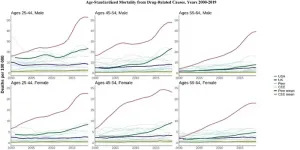(Press-News.org) A new study by researchers at the Leverhulme Centre for Demographic Science (LCDS) and Princeton University reveals that US working-age adults are dying at higher rates than their peers in high-income countries; the UK is also falling behind. The study is published today in the International Journal of Epidemiology.
Using annual mortality data from the World Health Organization Mortality Database, the study compared trends in midlife mortality for adults aged 25-64 years between 1990 and 2019 across 15 major causes of death in 18 high-income countries, including the US and UK, and seven Central and Eastern European countries.
Over the past three decades, the study found that most of these countries have experienced significant declines in midlife mortality from all possible causes of death, known as all-cause mortality. US improvements, however, were slower and interrupted by recent periods of stalling and reversals, depending on age and sex. As a result, by 2019, the US saw all-cause mortality rates that were 2.5 times higher than the average of other high-income countries studied.
Worsening midlife mortality in the US was driven by several causes of death, including highly preventable ones such as transport accidents, homicide, suicide and drug overdoses. For example, drug-related deaths in the US increased up to 10-fold (depending on sex and age group combination) between 2000 and 2019, diverging tremendously from other countries.
Dr Katarzyna Doniec, corresponding author of the study and Postdoctoral Researcher at LCDS and the Demographic Science Unit said, ‘Over the past three decades midlife mortality in the US has worsened significantly compared to other high-income countries, and for the younger 25 to 44 year old age-group in 2019 it even surpassed midlife mortality rates for Central and Eastern European countries. This is surprising, given that not so long ago some of these countries experienced high levels of working-age mortality, resulting from the post-socialist crisis of the 1990s.’
The study highlights the health disadvantage of younger US females aged 25-44 years old who were the only group across the 25 countries studied to experience higher mortality rates in 2019 than in 1990.
The UK is also falling behind its high-income peers with midlife mortality increasing for people aged 45-54, and death rates among 25-54 year olds stagnating instead of improving. Midlife mortality among 25-44 year olds also rose in Canada since 2013 alongside small increases for males of the same age range in Poland and Sweden, although these increases were far smaller than in the US.
While the UK performed relatively well on external causes of death such as suicide, homicide and traffic accidents, this was countered by stalling improvements in cardiovascular disease and cancer, and increasing drug deaths. The study also found that by 2019 younger females (25-44 year olds) in the UK fared worse than all high-income peers, except the US, and even some of the Central and Eastern European countries.
Professor Jennifer Dowd, lead author and Deputy Director of LCDS and the Demographic Science Unit said, ‘Our study adds to the evidence that UK mortality is increasingly diverging from its high-income peers, especially for younger women. The causes of this worsening health will be important to understand going forward.’
The study concludes that mortality declines witnessed in other high-income countries imply significant room for mortality improvement in both the US and UK. The study did not cover the years of the COVID-19 pandemic, when the life expectancy gap between the US and high-income countries widened further.
Editor’s notes
The study, ‘US exceptionalism? International trends in midlife mortality', appears in the International Journal of Epidemiology: https://doi.org/10.1093/ije/dyae024
For more information and interviews, please contact the Oxford Population Health press team (press@ndph.ox.ac.uk) and Dr Katarzyna Doniec (katarzyna.doniec@demography.ox.ac.uk).
About the Leverhulme Centre for Demographic Science
Based at Oxford Population Health, the Leverhulme Centre for Demographic Science and Demographic Science Unit are at the forefront of demographic research, disrupting and realigning demography for the benefit of populations around the world. Focussing on inequality, family, biosocial, digital, geospatial, and computational research, our researchers use new types of data, methods and unconventional approaches to tackle the most challenging demographic and population problems of our time.
END
New study highlights troubling trends in midlife mortality in the US and UK
2024-03-21
ELSE PRESS RELEASES FROM THIS DATE:
Nudging the public’s thirst for draught alcohol-free beers could significantly reduce alcohol-associated harms, new study finds
2024-03-21
Making alcohol-free beer more widely available on draught in pubs and bars may help people switch from alcoholic to alcohol-free beer, a new study published in Addiction today [21 March], has found. Pubs and bars taking part in the University of Bristol-led trial saw an increase in sales of healthier non-alcoholic draught beer.
In partnership with Bristol City Council (BCC), researchers from the University’s Tobacco and Alcohol Research Group (TARG) recruited 14 pubs and bars across the city that were willing to change the drinks that they offered on draught for a limited period. Previous research by the same group, using an online experiment as a proxy for real-world behaviour, ...
Millions are at risk using high arsenic water for cooking
2024-03-21
Around 32 per cent of the world's population live in countries that do not adhere to the World Health Organisation’s recommendations on safe limits of arsenic in drinking water
Rice is already known to contain more inorganic arsenic than other cereals
Cooking rice with water containing more than 10 µg L-1 (parts per billion) inorganic arsenic amplifies the risk of arsenic exposure
Long-term exposure to inorganic arsenic in water can cause serious health problems such as cancers, diabetes and pulmonary and cardiovascular diseases
Rice is one of the major cereal crops ...
TLI investigator Dr. Nicholas Jenzjowsky receives NIH/NIAID grant to investigate the neural regulation of asthma
2024-03-21
In a significant stride for respiratory medicine, Lundquist Institute (TLI) investigator Nicholas Jendzjowsky, PhD, has been awarded a prestigious grant from the National Institute of Health/National Institute of Allergy and Infectious Diseases (NIH/NIAID). This grant, totaling $298,800, not only underscores TLI's commitment to pioneering research and excellence in respiratory medicine and exercise physiology but also recognizes Dr. Jendzjowsky's expertise and the importance of his research.
The ...
Doctors’ pay in England has declined by 25% since 2008
2024-03-21
Doctors’ pay in England has declined by 25% since 2008
Independent analysis shows doctors’ salary erosion far outstrips other UK workers
Doctors describe how they struggle to afford everyday essentials
Trainee eye surgeon quit after worry over gas bill
As doctors in England enter their 13th month of industrial action, an independent analysis of their pay confirms that the real terms value of their salaries has declined by a quarter in the 15 years since their pay was frozen.
The analysis – conducted for The BMJ by the Office of Health Economics (OHE), an independent health economics research organisation – found that across ...
NIH grant funds research on work-related asthma among nurses
2024-03-21
A researcher at the University of Arizona Mel and Enid Zuckerman College of Public Health received a $750,000 National Institutes of Health grant to study the asthma risks associated with the use of cleaning and disinfecting products among nurses.
Cleaning processes in health care facilities involve an inherent “risk-risk tradeoff.” Increased use of cleaning and disinfection products leads to increased work-related asthma risks and simultaneously a decrease in occupational-infection risks.
Preliminary survey data indicate that nurses are generally willing to increase infection risks to maintain lower asthma risks if they think they will recover.
“Translating ...
AI tool predicts risk of side effects after surgery and radiotherapy in breast cancer patients
2024-03-21
Milan, Italy: A team of international researchers have developed an artificial intelligence (AI) tool that can predict which breast cancer patients may be at risk of side effects after surgery and radiotherapy.
Dr Tim Rattay told the 14th European Breast Cancer Conference (EBCC14) in Milan today (Thursday) that the tool will be tested in a clinical trial that will start recruiting in the last quarter of this year in three countries: France, The Netherlands and the UK.
“It is an explainable AI tool, which means that it shows the reasoning behind its decision-making. This makes it ...
Adding ribociclib to hormone therapy reduces the risk of breast cancer recurrence
2024-03-20
A new treatment approach that combines a targeted therapy drug with hormone therapy significantly increased the amount of time a person with stage 2 or 3 HR-positive, HER2-negative early breast cancer lives without the cancer returning, according to a new study co-led by UCLA Health Jonsson Comprehensive Cancer Center investigators.
The team found adding ribociclib, a drug that belongs to a class of CDK4/6 inhibitors, to standard hormone therapy not only improved invasive-free survival in women with this type of early-stage breast cancer, but also improves distant disease-free survival and recurrence-free survival.
The results were published today in the New England ...
Social isolation linked to biological age gap, higher mortality rate
2024-03-20
ROCHESTER, Minn. — A new study from Mayo Clinic finds that socially isolated people are more likely to show signs of being biologically older than their age and more likely to die from a variety of causes. The research, published in the Journal of the American College of Cardiology: Advances, suggests that social connection plays an important role in overall physical health and longevity, and it should be addressed as a necessary part of the social determinants of health.
To investigate the role of social contact in biological aging, the ...
New commentary: Combatting digital redlining is imperative for advancing health equity
2024-03-20
Broadband plays a critical role in most aspects of modern-day life, yet over 42 million Americans still lack access to high-speed Internet. This digital divide is driven by “digital redlining”—discriminatory disinvestment in broadband infrastructure that disproportionately affects people of color, low-income communities, and rural populations, worsening disparities in access to healthcare, social services, education, and employment for these populations.
Addressing digital redlining and the digital divide is imperative for ...
Drug-pricing program improved prostate cancer treatment adherence
2024-03-20
ANN ARBOR, Michigan — Prostate cancer patients receiving care at hospitals that are part of a special drug-pricing program were more likely to stick to their prescription drug therapy than patients at other hospitals, according to a study from researchers at the University of Michigan’s Rogel Cancer Center and Institute for Healthcare Policy and Innovation.
The 340B Drug Pricing Program is a federal program that requires the pharmaceutical industry to provide a discount on the cost of drugs to participating hospitals who serve a disproportionate number of Medicare and Medicaid patients. The program was started to enable hospitals to stretch scarce resources, ...





